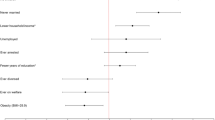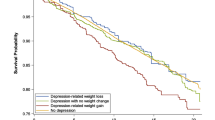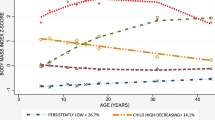Abstract
Depression may be a risk factor for overweight status, but mechanisms involved in this relationship are unclear. This study explored behavioral factors involved in the relationship between adolescent depression symptoms and adult overweight status. A population-based cohort of female participants in Project EAT (n=1035) was followed over 10 years and reported on psychological functioning, weight status and eating and activity patterns in early/middle adolescence (1999=Time 1; T1), middle adolescence/early young adulthood (2004=Time 2; T2) and early/middle young adulthood (2009=Time 3; T3). Structural equation models were fit which included T1 depression scores predicting overweight status at T3, with T2 fruit and vegetable consumption, moderate-to-vigorous physical activity and binge eating examined as mediators. There were small but significant effects of T1 depression scores predicting an increased likelihood of T3 overweight status (standardized estimate=0.038; P=0.007), and of T2 binge eating mediating the relation between T1 depression and T3 overweight status (standardized indirect effect estimate=0.036; P=0.009). Binge eating may be one pathway to overweight among depressed females, suggesting that recognition and treatment of eating pathology in individuals with depression may help prevent overweight. Examination of other behavioral (and non-behavioral) factors explaining the relationship between depression and overweight is warranted.
This is a preview of subscription content, access via your institution
Access options
Subscribe to this journal
Receive 12 print issues and online access
$259.00 per year
only $21.58 per issue
Buy this article
- Purchase on Springer Link
- Instant access to full article PDF
Prices may be subject to local taxes which are calculated during checkout

Similar content being viewed by others
References
Wang YC, McPherson K, Marsh T, Gortmaker SL, Brown M . Health and economic burden of the projected obesity trends in the USA and the UK. Lancet 2011; 378: 815–825.
National Institute for Health and Clinical Excellence Depression in Adults: The Treatment and Management of Depression in Adults. National Collaborating Centre for Mental Health: London, UK, 2009.
Faith MS, Butryn M, Wadden TA, Fabricatore A, Nguyen AM, Heymsfield SB . Evidence for prospective associations among depression and obesity in population-based studies. Obes Rev 2011; 12: e438–e453.
Gibson EL . The psychobiology of comfort eating: implications for neuropharmacological interventions. Behav Pharmacol 2012; 23: 442–460.
Cook CM, Schoeller DA . Physical activity and weight control: conflicting findings. Curr Opin Clin Nutr Metab Care 2011; 14: 419–424.
Sonneville KR, Horton NJ, Micali N, Crosby RD, Swanson SA, Solmi F et al. Longitudinal associations between binge eating and overeating and adverse outcomes among adolescents and young adults: does loss of control matter? JAMA Pediatr 2013; 167: 149–155.
Haedt-Matt AA, Keel PK . Revisiting the affect regulation model of binge eating: a meta-analysis of studies using ecological momentary assessment. Psychol Bull 2011; 137: 660–681.
Fulkerson JA, Sherwood NE, Perry CL, Neumark-Sztainer D, Story M . Depressive symptoms and adolescent eating and health behaviors: a multifaceted view in a population-based sample. Prev Med 2004; 38: 865–875.
Katon WJ, Russo JE, Heckbert SR, Lin EH, Ciechanowski P, Ludman E et al. The relationship between changes in depression symptoms and changes in health risk behaviors in patients with diabetes. Int J Geriatr Psychiatry 2010; 25: 466–475.
Brunet J, Sabiston CM, Chaiton M, Barnett TA, O'Loughlin E, Low NC et al. The association between past and current physical activity and depressive symptoms in young adults: a 10-year prospective study. Ann Epidemiol 2013; 23: 25–30.
Quick V, Wall M, Larson N, Haines J, Neumark-Sztainer D . Personal, behavioral and socio-environmental predictors of overweight incidence in young adults: 10-yr longitudinal findings. Int J Behav Nutr Phys Act 2013; 10: 37.
Neumark-Sztainer D, Story M, Hannan PJ, Croll J . Overweight status and eating patterns among adolescents: where do youths stand in comparison with the healthy people 2010 objectives? Am J Public Health 2002; 92: 844–851.
Kuczmarski RJ, Ogden CL, Grummer-Strawn LM, Flegal KM, Guo SS, Wei R et al. CDC growth charts: United States. Adv Data 2000; 314: 1–27.
Kandel D, Davies M . Epidemiology of depressive mood in adolescents. Arch Gen Psychiatry 1982; 39: 1205–1212.
Yanovski SZ . Binge eating disorder: current knowledge and future directions. Obes Res 1993; 1: 306–324.
Nangle DW, Johnson WG, Carr-Nangle RE, Engler LB . Binge eating disorder and the proposed DSM-IV criteria: psychometric analysis of the Questionnaire of Eating and Weight Patterns. Int J Eat Disord 1994; 16: 147–157.
Rockett HR, Breitenbach M, Frazier AL, Witschi J, Wolf AM, Field AE et al. Validation of a youth/adolescent food frequency questionnaire. Prev Med 1997; 26: 808–816.
Godin G, Shephard RJ . A simple method to assess exercise behavior in the community. Can J Appl Sport Sci 1985; 10: 141–146.
Sallis JF, Buono MJ, Roby JJ, Micale FG, Nelson JA . Seven-day recall and other physical activity self-reports in children and adolescents. Med Sci Sports Exerc 1993; 25: 99–108.
Serretti A, Mandelli L . Antidepressants and body weight: a comprehensive review and meta-analysis. J Clin Psychiatry 2010; 71: 1259–1272.
Acknowledgements
This study was supported by grant R01-HL084064 from the National Heart, Lung and Blood Institute (DNS), and ABG’s time was supported by KL2-RR025000 from the National Center for Research Resources. The content is solely the responsibility of the authors and does not necessarily represent the official views of the National Heart, Lung and Blood Institute or the National Institutes of Health. ABG conceived of the research question and wrote the manuscript. MMW and TJC carried out the analyses. NIL collected and managed the data. DNS designed the study. All authors contributed to and approved the final manuscript.
Author information
Authors and Affiliations
Corresponding author
Ethics declarations
Competing interests
The authors declare no conflict of interest.
Rights and permissions
About this article
Cite this article
Goldschmidt, A., Wall, M., Choo, TH. et al. Mediators involved in the relation between depressive symptoms and weight status in female adolescents and young adults. Int J Obes 39, 1027–1029 (2015). https://doi.org/10.1038/ijo.2015.6
Received:
Revised:
Accepted:
Published:
Issue Date:
DOI: https://doi.org/10.1038/ijo.2015.6
This article is cited by
-
Change in diet in the period from adolescence to early adulthood: a systematic scoping review of longitudinal studies
International Journal of Behavioral Nutrition and Physical Activity (2017)



